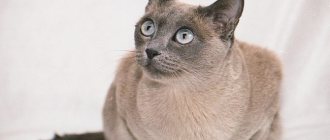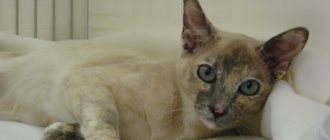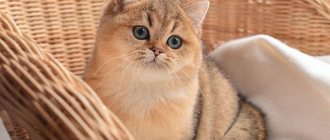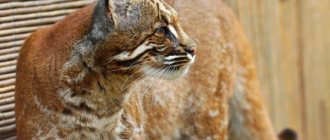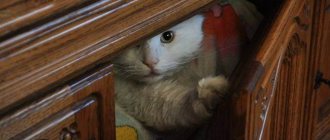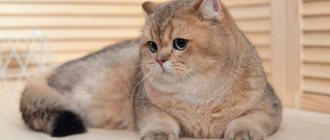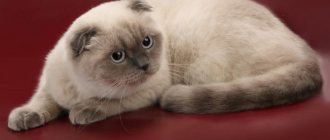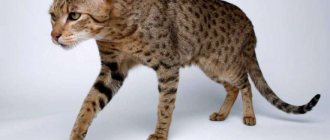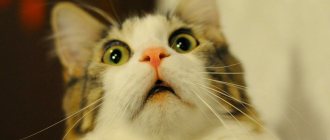Active breeding of this cat breed began in the 60s of the 20th century, and in 1998, according to CFA data, this breed was one of the ten most popular cat breeds. The artificial crossing of the Burmese and Siamese cats was preceded by the natural crossing of these two cat breeds living in the vicinity of Thailand during the reign of the Ayudhaya dynasty, between 1350 and 1767. The first chocolate Siamese cats appeared in England in the 19th century, along with the more popular blue-eyed color-point Siamese cats. At the beginning of the 20th century, experts identified blue-eyed cats among Siamese cats, and the remaining varieties of Siamese were prohibited from participating in exhibitions, so many species gradually lost their popularity and disappeared. But the Tonkinese cat was able to regain interest thanks to the Canadian breeder Margaret Conroy, who crossed a sable-colored Burmese with a seal-point Siamese cat. Thanks to this experiment, light brown kittens with unusual aquamarine eyes were born. Initially, the breed was called the Golden Siamese, and already in 1971 the modern name Tonkinese cat appeared, as experts suggest, the cat received this name from the name of the Tonkin lowland, located in Vietnam, although representatives of this breed have never been in this area. This name was intended to emphasize the refined exotic beauty of these cats. DescriptionCharacterCareCost
Description of the breed
The Tonkinese cat is the result of crossing Burmese and Siamese cats. The Tonkinese cat is most popular among people who like the Siamese cat but would like a cat with a more moderate head and body shape. The Tonkinese is slimmer than the Burmese, but has a denser build than the Siamese cat. Tonkinese are unusually heavy compared to their size. These are strong, hardy animals with developed muscles. Body weight ranges from 3 to 5 kg, males are larger than females. The wedge-shaped head of the Tonkinese is elongated, the ears are medium-sized, set high, and the almond-shaped eyes are located slightly obliquely. The color can be of three different types: solid, color point and mink. For participation in shows, most associations welcome the mink color; only some associations accept color-point and solid colors for participation in shows. A characteristic feature of the mink color is its blue eyes. Blue eyes are also found in color-point cats, and in solid-colored cats they range from greenish to golden. Currently, the natural color standard is characterized by a warm brown coat with dark chocolate markings, and a pale gray coat with dark gray markings, which is called platinum. The color called champagne is also welcome - it is a light beige color with faint, barely noticeable brown markings; There is also a blue mink color, blue with gray-blue markings. Less common colors are fawn, cream, red, and cinnamon. They are not accepted by most associations.
Features of behavior
The Tonkinese cat, despite the fact that it originated from the Siamese, has a very light and docile character in comparison with them. She did not inherit attacks of jealousy and rancor from her Siamese “relatives”. Tonkinese dogs are very gentle and obedient, so raising them does not pose any particular difficulties.
Representatives of this breed are companion cats. They quickly and firmly become attached to their owner and are ready to accompany him everywhere. Tonkinese dogs are happy to walk on a leash, but on the contrary, they do not like to be left alone at home. Therefore, it is best to take your cat with you on walks in the park or on a trip to the country.
Tonkinese cats are very inquisitive and playful. However, it is not in their nature to tear up the sofa in the game or scratch the closet in search of interesting places. These cats love to sit on their owner's shoulder, surveying the surroundings.
Tonkinese are not shy, they are sociable and easily get along with strangers. So if there are often guests in the house, then the Tonkinese cat is the best pet.
Character
By its nature, Tonkinese is very pleasant to communicate with. This is a kind, active, smart cat. The Tonkinese will not irritate you with increased talkativeness like a Siamese cat, and his voice is quieter and more pleasant. The Tonkinese loves to accompany its owner everywhere, he will sit next to you, follow you on your heels, flirt and attract your attention in various ways. This cat breed is not suitable for those who are often away from home. To save your pet from loneliness when you are away, get another cat so that they can play together and spend time without you.
Cost of a kitten
Despite the wide distribution of the Siamese breed, it is almost impossible to find real Tonkinese in our country.
If you want to become the owner of just such a pet, you should contact one of the nurseries in the United States of America, Canada or Europe.
The cost of a pet-class kitten will not be less than five hundred dollars; animals of the breeding class (for breeding) and show classes will be sold at a price of eight hundred dollars and more.
1111
Care
Tonkinese are unpretentious in care. Their health is good. Since the Tonkinese coat is short and lies close to the body, it does not require much attention when grooming. It is enough to brush your cat once a week, and it will look great. For grooming, it is better to use a rubber brush with a concave surface to more effectively remove dead hair. As for the rest, you should do everything the same as when caring for a regular cat, periodically bring the cat for examination by a veterinarian, vaccinate and carry out grooming procedures.
Health of the Tonkinese
Unfortunately, Tonkinese dogs do not have very good health. They can inherit some dangerous diseases and are also susceptible to some intestinal and respiratory infections. With proper care and care, the life expectancy of the Tonkinese is about 12 years.
Gingivitis
Gingivitis is an inflammation of the gums, one of the symptoms of periodontal disease. It appears as redness of the gums around the teeth. Very often, gingivitis affects not only the gums, but also bone tissue.
gingivitis is an inflammatory disease of the gums
Most often, gingivitis occurs for the following reasons:
- lack of oral hygiene;
- congenital malocclusion;
- vitamin deficiency (especially lack of vitamins A and C);
- the appearance of tartar;
- gum injuries;
- infections and viruses;
- old age and poor nutrition.
Gingivitis is treated with special medications. During treatment, be sure to feed your cat only soft pureed food and perform daily oral hygiene.
Burmese skull defect
Tonkinese cats inherited this genetic disease from Burmese cats. Burmese Head Defect (BHD) appears at a very early age (1–2 weeks) due to a mutant gene that is inserted into the cat’s genome and triggers the process of improper formation of the skull.
Burmese skull defect appears at an early age
The manifestation of a skull defect depends on the number of copies of the mutant gene. If a cat has only one copy of the gene, then it develops brachycephaly (short head, like Persians and exotics). If there are 2 copies, then the kitten inevitably dies from deformations of the skull incompatible with life.
A test has now been developed that can detect a mutant gene in a cat’s genome. Cats with this gene cannot be used for breeding.
Inflammatory bowel diseases
Experts are still arguing about what exactly causes IBD. At the moment, the objective cause is considered to be a negative intestinal reaction to food ingredients, chemicals, medications, etc.
IBD symptoms:
- diarrhea;
- vomit;
- weight loss;
- stomach ache;
- the presence of bright red blood during bowel movements;
- animal passivity;
- rumbling in the stomach, gases;
- weight loss.
Treatment is carried out by changing the diet and special medications. The exact treatment is prescribed by the veterinarian based on the individual needs of the cats.
Upper respiratory tract infections
Upper respiratory tract infections affect a cat's nasal passages, throat, and sinuses. Caused by certain feline viruses that a cat can become infected with. As a rule, infection occurs from animal contact with sick cats or with things that a sick cat has been near.
Symptoms:
- discharge from the nose and eyes;
- frequent coughing and sneezing;
If your cat is constantly sneezing and coughing, this could be a sign of an upper respiratory tract infection. - in more serious cases: fever;
- yellow-green nasal discharge;
- enlarged lymph nodes.
The disease is very dangerous if left untreated. At the slightest suspicion of infection, you should contact your veterinarian.
Amyloidosis
Amyloidosis is a rare disorder of protein metabolism. When it occurs, amyloid protein accumulates in the pancreas, kidneys or liver. This causes organ dysfunction. Amyloidosis can occur for the following reasons:
- hereditary disease;
- severe or chronic poisoning;
- reaction to serious infections.
Older animals are most often affected. Symptoms:
- anorexia;
Anorexia is common in cats with amyloidosis. - lethargy;
- sudden weight loss;
- severe shortness of breath;
- excessive thirst and a sharp increase in urination;
- yellowness of mucous membranes;
- lack of appetite and lethargy;
- deterioration of the condition of the cat's fur and hair.
The disease is considered incurable, you can only alleviate its symptoms.
Hypertrophic cardiomyopathy
Hypertrophic cardiomyopathy is the most common and is characterized by thickening of the walls of the heart, causing it to work worse and not be supplied with oxygen.
Hypertrophic cardiomyopathy affects a cat's heart, making it less elastic
Symptoms can be detected in the early stages by a veterinarian:
- galloping heart rhythm;
- arrhythmia;
- pulse pathology;
- heart murmurs;
- hypertension.
Cardiomyopathy is often observed against the background of other diseases: acromegaly, bull's heart, lymphoma. It may occur due to bad heredity. By treating the underlying disease, cardiomyopathy can be significantly alleviated and even eliminated.
Cat breeds
Did you think you knew everything about cat breeds? Test your knowledge on the official website of German natural pet food Bosch. We present an extensive catalog of various cat breeds. The section contains more than 70 reference articles. The names of cat breeds with detailed descriptions and high-quality photos will be of interest to both experienced cat lovers and those who are just thinking about buying an animal.
If you do not want to search alphabetically, write the desired cat breed and use the search bar. Each description of cats with photographs is divided into several parts: a brief information about the breeding of the breed, then a detailed description of the physiological characteristics - for example, the shape of the head, ears and eyes, the size of the body, the nature of the color, the length of the coat, etc.
Origin story
The first mention of these cats is found in the literature of Siam from the 14th to 18th centuries. They were brought to England in the early 1800s and were called "Chocolate Siamese." In the USA, the ancestor of the breed was the Wong Mau cat, which was brought by Dr. Joseph Thompson in 1930.
Officially, the homeland of the Tonkinese is Canada, where the main crossbreeding program between the Siamese and Burmese breeds was implemented.
It all started when Canadian breeder Margaret Conroy found herself with a very shy Burmese cat. She refused all cats, and was tempted only by the Siamese. The result was kittens with tinted colors and sea green eyes. Later they began to be brought together with the descendants of the American Wong Mau.
Descriptions, photographs and character
For future owners of graceful creatures, the section on the character of various breeds of cats and kittens will be extremely useful. Here you can find out how your pet tends to communicate with people - affectionate and trusting or emphatically independent and even sometimes aggressive? Or perhaps kittens are future excellent hunters, playful and curious, which means it will be impossible to lock the warlike tailed one within four walls. A detailed description of the breed will help you make the right choice. We especially note that the catalog contains expensive and rare cat breeds.
Often the determining factor when choosing a pet is its appearance. Especially if you entrust the choice of a pet to children. But when looking at photos of cat breeds, do not forget that only a careful acquaintance with the description of the character can serve as a guarantee that in the future there will be no disagreements between you and a tailed family member.
Exhibitions
Before purchasing a pet, the future owner must decide whether he wants to attend exhibitions. If you have such a desire, then it is better to take a Tonkinese-type kitten, i.e. with mink coat color, because Only they can participate in exhibitions and receive titles in systems that recognize the breed. Only such animals should also be allowed for breeding, but some of the associations (TICA, AACE, CFF) do not prohibit crossbreeding of intrabreed types.
Tonkinese dogs are recognized in the WCF, TICA, ACF, CFA, GCCF, ACFA, AACE, CFF systems - before registering a pet for an exhibition, it must be taken into account that it was organized by one of these associations, otherwise it will only receive an assessment and description from an expert.
